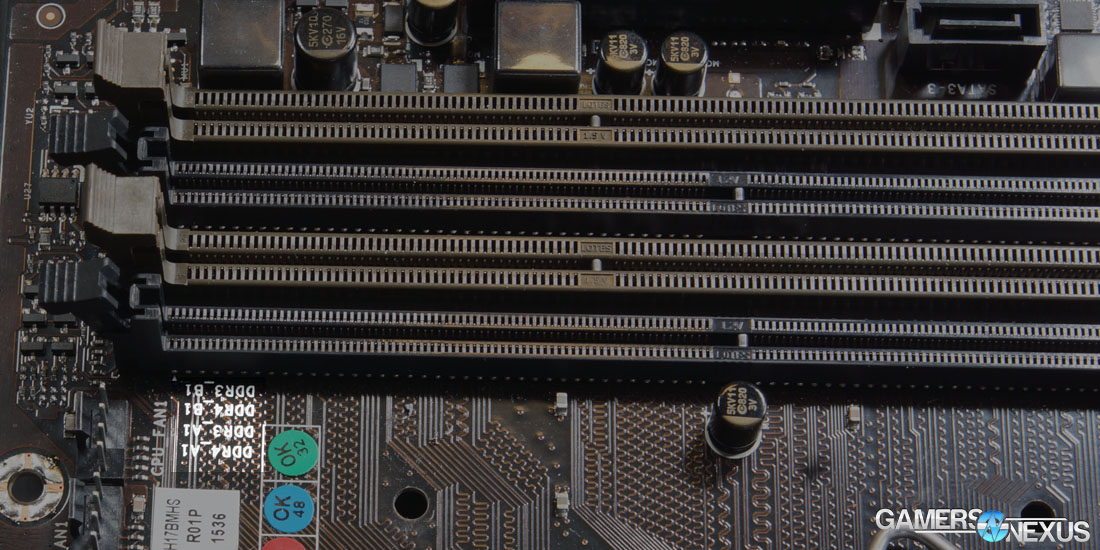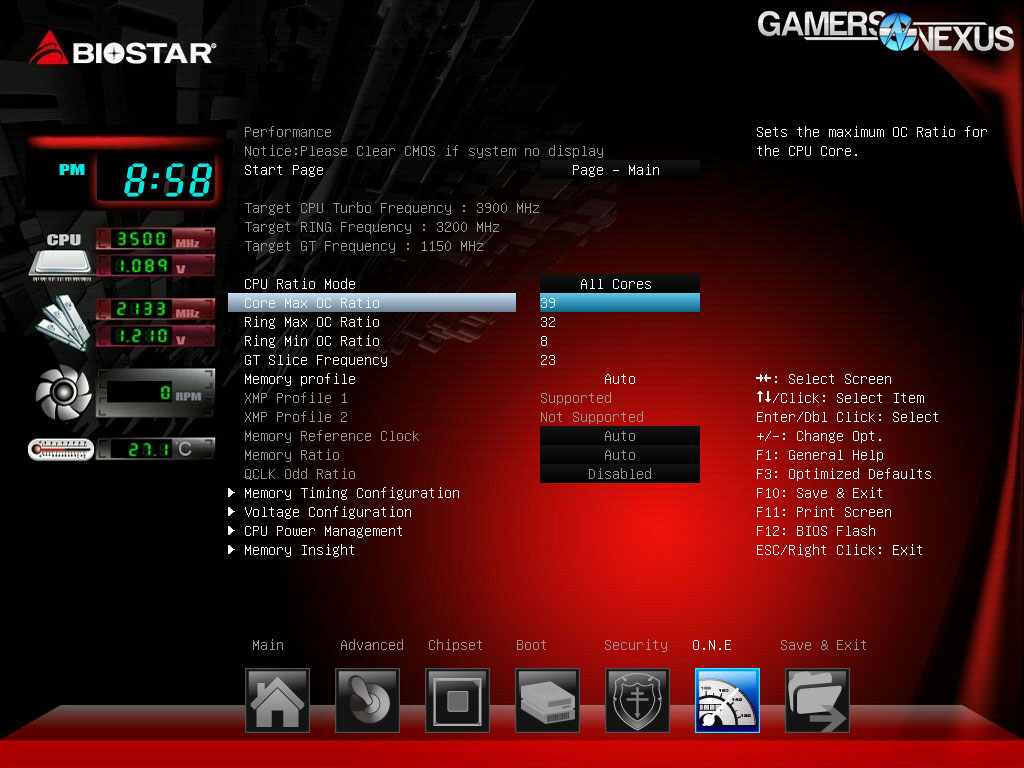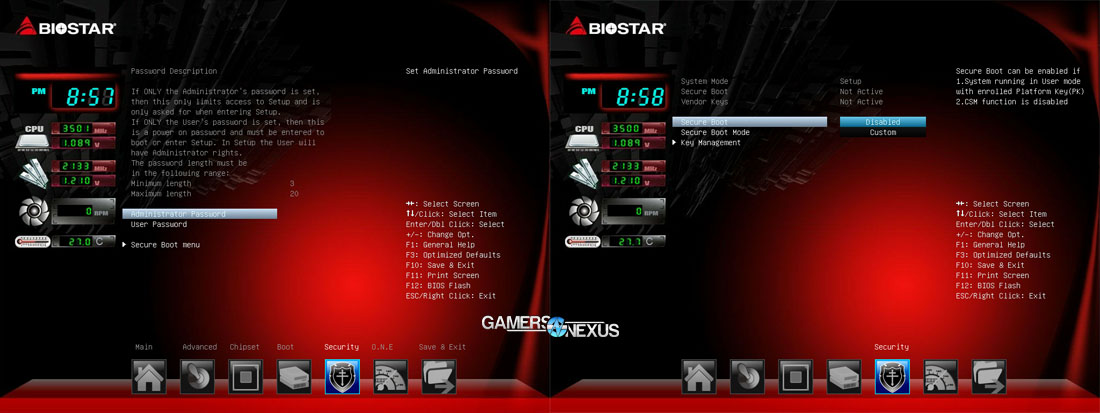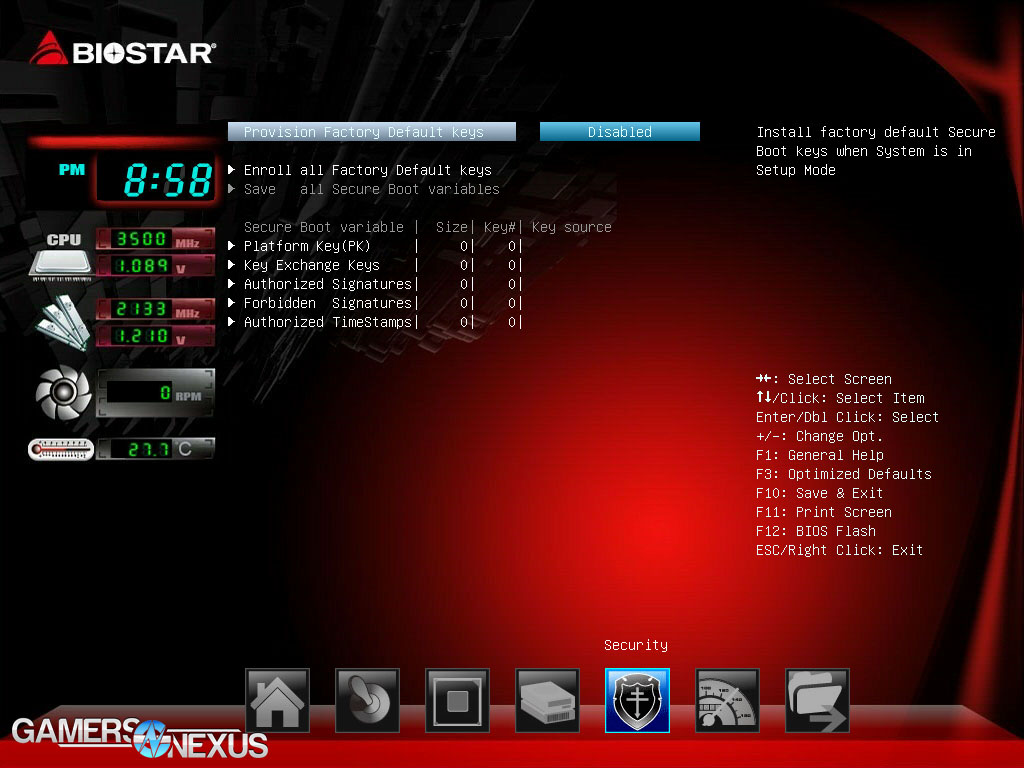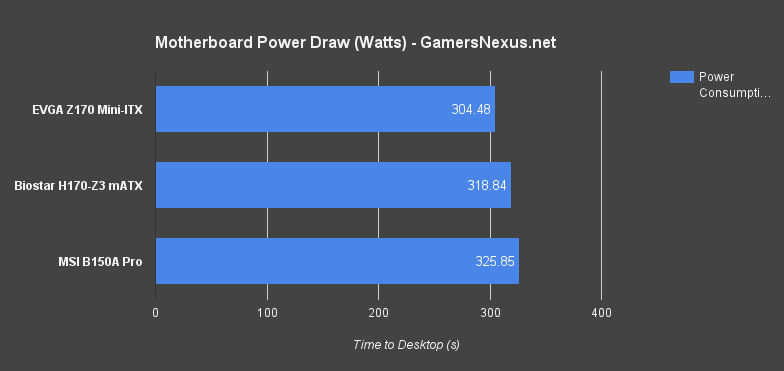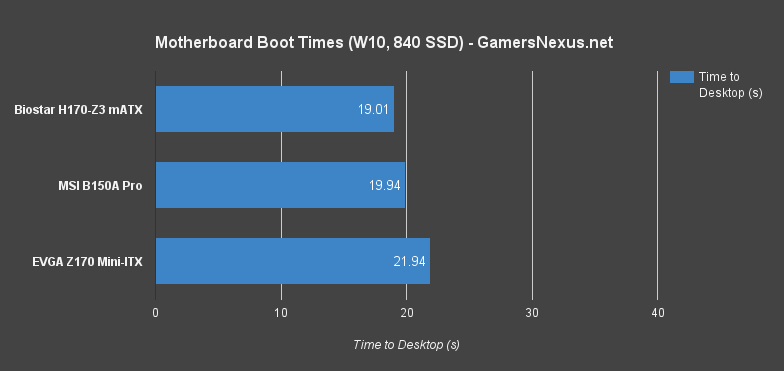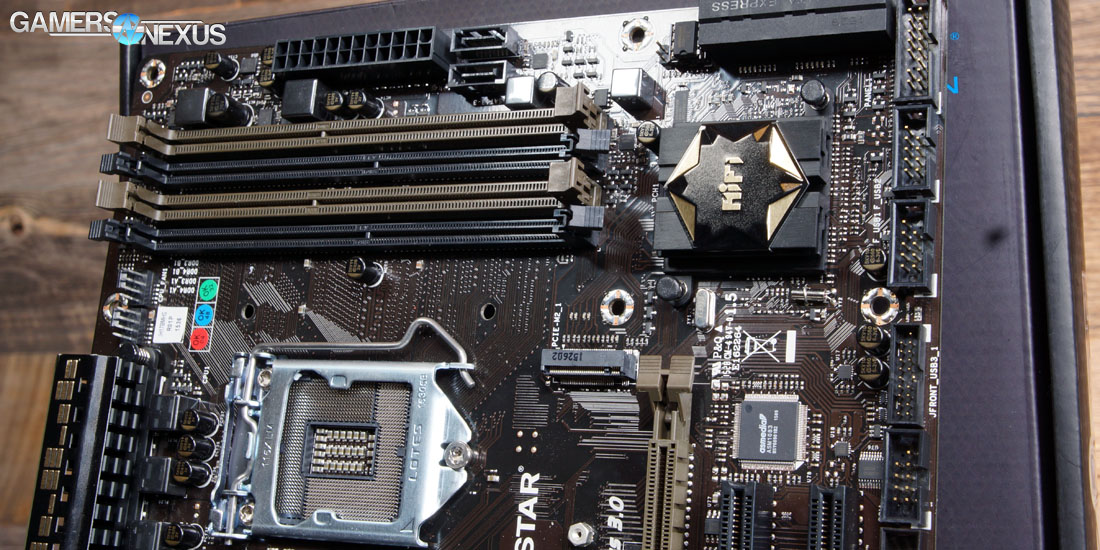Biostar Hi-Fi H170-Z3 Motherboard Review – DDR3L & DDR4 on H170
Posted on October 29, 2015
Skylake's launch caused some initial curiosity because of its split RAM compatibility. The Skylake memory controller is capable of running both DDR4 and DDR3L memory – but not both simultaneously – and is compatible with platforms hosting both memory slot types. Importantly, DDR3 is not the same as DDR3L (low voltage), so just re-using Z97 platform DDR3 sticks won't necessarily (but could) work with Skylake boards.
Biostar's Hi-Fi H170-Z3 motherboard is among the first options to support both DDR3L and DDR4. With four DIMM slots and two per memory type, you're limited to a single DIMM per channel (dual-channel supported) with a maximum of 2 sticks per configuration. Using DDR4, a maximum memory configuration of 32GB (16GB per slot) is supported, with just 16GB (8GB per slot) on DDR3L.
Today we're reviewing the Hi-Fi H170-Z3. We've gone through the board design, UEFI, and some basic objective tests. Being that the board uses the H170 chipset, overclocking was not possible and not tested.
Intel H170 vs. Z170 Chipset Specs
| Z170 | H170 | H110 | |
| HSIO Lanes | 26 | 22 | 14 |
| Chipset PCI-e Lanes | x20 3.0 | x16 3.0 | x6 2.0 |
| PCI-e 3.0 Config | 1 x16 2 x8 1 x8 + 2 x4 | 1 x16 | 1 x16 |
| CPU Overclocking | Yes | No | No |
| Memory Channels | 2 | 2 | 2 |
| DIMMs per Channel | 2 | 2 | 1 |
| Native SATA 3.0 Ports | 6 | 6 | 4 |
| Max USB Ports | 14 | 14 | 10 |
| Max USB3.x Ports | 10 | 8 | 4 |
| Intel SRT | Yes | Yes | No |
| RAID 0/1/5/10 | Yes | Yes | No |
| RST via PCI-e | 3 | 2 | 0 |
| Independent Displays | 3 | 3 | 2 |
| Smart Sound | Yes | No | No |
| Intel SBA | No | Yes | No |
| Intel SBB | No | Yes | Yes |
| I/O Flexibility | Yes | Yes | No |
Biostar H170-Z3 Motherboard Specs
This board uses an H170 chipset, meaning that it is limited in some ways which the Z170 is not – read the chipset differences here – but is more affordable to the mainstream market.
Biostar's micro-ATX, split-memory H170 board is outfitted with 2x SATA Express ports on-board, a single M.2 gum-stick SSD slot (4x PCI-e lanes from the chipset), and 4x SATA III ports (note that SATA-E can be used alternatively for two additional SATA III slots).
Some Odd Choices
The expansion slot configuration confusingly sports two PCI non-E slots, with 1x PCI-e x1 and 1x PCI-e x16. One of the two PCI slots is completely obstructed by any 2-slot GPU anyway, leading us to further question the choice of inclusion – it's almost like these board manufacturers, knowing that SLI support is limited with some chipsets, have nothing better to put there; we think nothing would be better.
Not a big deal, though. Just a useless port these days, especially when it's going to be covered by most GPUs on the market.
Moving on to the front-panel options, two FP USB2.0 headers and an FP 3.0 header are present. The FPC somewhat annoyingly has an exterior wall enclosing the pins, another small issue that could be quickly resolved in future iterations. Labeling on the FPC would have been welcomed, but it's not a big deal to refer to the manual for front panel connections.
Biostar's H170-Z3, like a few other low-to-mid tier motherboards, still offers COM and Parallel headers on-board. Asian and global markets still have some hangers-on to COM and Parallel (particularly factories), though the US market has almost no use for these legacy ports. Programming a router could still jack-in to legacy ports, though if you're really doing that, you probably have a USB adapter at this point.
Walking Through the Rest
One choice we really liked – and it's simple – was the decision to make all fan headers 4-pin (PWM) and exclude use of 3-pin headers. There are also 6x 3.5mm audio jacks for higher-end audio solutions (that still don't have a discrete processor) and surround configurations, alongside the soon-obsolete S/PDIF (being replaced by other digital surround interfaces).
An infrared header is on-board for use with HTPC controllers or other remote inputs, potentially applicable to some use cases.
Rear IO consists of the 6x 3.5 jacks, 4x USB3.0, 2x USB2.0, and all four video interfaces (DisplayPort, HDMI, DVI, VGA). Gigabit Ethernet is present as expected, including welcomed surge / fault protections for areas with unstable power.
The H170 chipset bears a small heatsink with “Hi-Fi” branding, mirroring the board's LED-illuminated Hi-Fi audio logo (using red LEDs). Branding is a mix of black and gold-ish heatsinks with a matte black PCB; some red LEDs are present, but the board is otherwise simple in its appearances.
The CPU-adjacent VRM heatsinks exhibit a little play when pressed thanks to their reliance upon plastic mounting clips, but the thermal pads still make full contact with VRM components / MOSFETs. We think this to be a non-issue, functionally, and just a matter of the mounting hardware.
DDR3L & DDR4 Slots on a Motherboard
Because DDR3L and DDR4 have different voltages, timings, and because of the way Skylake's memory controller works, only two of four slots can ever be filled on this motherboard. The two kits cannot be mixed. For our testing, we used the DDR4 slots, which afford greater capacity than the DDR3 slots. The maximum DDR3L spec is 2x 8GB at 1600MHz; DDR4 can run up to 2x16GB at 2133MHz natively.
The big question here is one of implementation. In what scenario does a user want both DDR3L and DDR4 on a motherboard? Certainly for benchmarking – but that's an incredibly small market (and that'd probably be a Z170 board, anyway). Outside of this, I suppose if a user wanted to use a kit of DDR3L that they already own for the initial build, then upgrade to DDR4 at a later date, this kind of could make sense.
I can't think of a lot of valid reasons to want both memory options on a platform. For the most part, it's just going to become a restriction – limiting to single DIMM per channel configurations – but we'll revisit this in the conclusion.
UEFI & BIOS
Biostar uses a DIP chip for its BIOS rather than an SMD. The Z3's firmware visualizes hardware monitoring information on the left side, showing the CPU_FAN RPM, CPU temperatures, and MEM / CPU specs (frequency and voltages). UEFI options are fairly barebones compared to a Z170 chipset, particularly when it comes to the locked overclocking functionality.
Biostar's “O.N.E” menu allows CPU multiplier up-ticking to the Turbo clock so that users can force an always-active Turbo Boost setting, but no further overclocking is permitted. This is a limitation of the chipset. Over-volting is available, should the forced Turbo require increased voltage, and is extended to DRAM OV for offsetting unstable (but limited) frequencies. CPU C States can be disabled or enabled, coinciding with standards, and the power limiters can be lightly tuned through O.N.E. This is about the extent of the overclocking tab.
Hardware monitoring is a little more interesting. CPU fan speeds can be set to “Smart” (dependent upon load and PWM-controlled), with system fans configurable to custom fan curves mapped versus temperature.
UEFI on the H170-Z3 has a big focus on security features, recapped most quickly with screenshots:
The H170-Z3 is prepped with a fairly feature-complete set of Secure Boot features, including platform key management, authorized signatures, and timestamps. The Z3 is ready for small business deployments in this regard.
Mouse input feels a little “laggy,” but that's really a non-issue in the scheme of things. Keyboard input is responsive and functions as expected.
Test Methodology
We're still developing Z170 & H170 / Skylake test methodology and, until we've received production-level boards and chips, we can't do a lot of direct comparisons. As it stands now, our Core i7-6600K is a pre-production sample.
For now, we've only done power draw and boot time comparisons, with OC testing being relegated to only relevant Z170 boards.
Power draw was tested with BIOS settings configured to default, sans memory (DDR4-2133MHz). Intel's power saving options were enabled as recommended for this test. Idle and load were both measured with a wall-to-plug Kill-A-Watt meter. Load was tested by running 3DMark Firestrike Extreme (combined test) on loop for ten minutes, at which point the total system power draw was plotted.
Boot times were stop-watch timed. Fast boot was disabled. No OC was applied. Memory was at 2133MHz. Tests were repeated for parity a minimum of 5 times.
Bench is below.
| GN Test Bench 2015 | Name | Courtesy Of | Cost |
| Video Card | NVIDIA | $650 | |
| CPU | Intel i7-6600K CPU | iBUYPOWER | $240 |
| Memory | 16GB HyperX Predator DDR4-3000 | Kingston Tech. | - |
| Motherboard | This is what we're testing! | - | - |
| Power Supply | NZXT 1200W HALE90 V2 | NZXT | $300 |
| SSD | Kingston V300 SSD | iBUYPOWER | - |
| Case | Top Deck Tech Station | GamersNexus | $250 |
| CPU Cooler | NZXT Kraken X61 | NZXT | - |
Note: We've moved to Windows 10 and use an i5-6600K as of the Biostar H170-Z3 review, so previous motherboard reviews are not comparable to our modern reviews.
Biostar H170-Z3 Motherboard Power Draw
It's no surprise that the stripped-down, mini-ITX board from EVGA runs at a lower power consumption than the other on-bench motherboards. Full system load (980 Ti, 6600K, and the other specs listed above) shows the micro-ATX H170-Z3 operating at 318.84W, compared against the mini-ITX EVGA Z170 at 304.48W and full-ATX MSI B150A Pro at 325.85W.
Biostar H170-Z3 Motherboard Boot Times
Biostar's H170-Z3 motherboard has the fastest boot time on our current bench, beating out the MSI B150A Pro by 0.93s and the EVGA Stinger by 2.93s. The H170-Z3 jumps to the desktop around 19 seconds after pressing the power button.
Conclusion
Biostar's H170-Z3 offers all the features wanted from an H170 chipset motherboard, even throwing-in some limited overclocking functionality that locks the CPU into Turbo mode at all times. The board's got plenty of limitations that should steer enthusiasts away – H170 doesn't support multi-GPU configs, has fewer HSIO lanes, and there's no CPU/DRAM OC support – but builders on a budget have reason to consider the H170-Z3. UEFI presents all the security features you'd want for the average small business operation and no-nonsense features for business or mainstream system builders.
But there's the big feature: Biostar's $105 H170-Z3 supports DDR3L and DDR4, which makes the motherboard limited in its memory expansion capabilities. It's also appealing to profoundly specific markets, like users who want to use DDR3L as a gateway to DDR4 upgrades. Looking at the DDR4-only H170 competition, we see the Gigabyte GA-H170M-DS3H for $90, the ASRock H170M Pro4 for $95, and the ASUS H170M-PLUS for an equal $105. That's a lot of competition, and all of it can support four full DIMM slots of DDR4 – more room for upgrades.
The only reason to buy the Biostar H170Z3 is in the event that you already own DDR3L, want to shift to Skylake, and don't have budget to spend $50 on DDR4 memory. If you're in that group, we liked the H170-Z3 well enough, found its UEFI to be feature-complete, liked the security features, and found its boot times to lead the pack by a small (but measurable) margin.
The Biostar H170-Z3 should be available via Biostar's eBay page soon. Biostar has no plans to sell through Amazon at this time.
- Steve “Lelldorianx” Burke.
